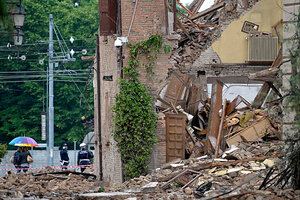Italy earthquake: modern buildings, not ancient ones, pose biggest threat
The Italy earthquake suggests that danger lies not so much in ancient monuments as in the many buildings constructed between the late 1940s and the early 1970s.

Residents wander outside a collapsed church in San Felice sul Panaro, northern Italy, Sunday, May 20. A 5.9 magnitude earthquake shook northern Italy early Sunday.
Marco Vasini/AP
Milan, Italy
On Friday a group of Italian architects wrote an open letter criticizing the lack of security standards for private and public buildings in Italy, warning that there are “6 million buildings facing grave seismic risks.”
The document, bearing the signature of the National Council of Architects (the document can be viewed, in Italian, here), went unnoticed until Sunday, when a magnitude-5.9 earthquake shook northern Italy, leaving at least seven people dead and 4,000 homeless.
Yesterday's quake was the third major earthquake to hit Italy in the past decade. It was not the strongest, nor did it cause the most damage, but it is a reminder of the importance of building standards in the country. Similar to the aftermath of the 2009 earthquake that almost destroyed the entire city of L'Aquila in central Italy (read Monitor coverage here), the Sunday quake has prompted public questioning about the alleged lack of prevention measures to avoid high casualties.
Hardest hit by the earthquake was the Emilia Romagna province in northern Italy, a region renowned for its culinary exports, such as Parmesan cheese, lasagna, and tortellini. It is also well known for its medieval architecture. And, while images of a collapsed 13th century tower in the ancient town of Finale Emilia have been broadcast worldwide, it was the collapse of a modern building in a suburb of Ferrara that was most deadly, killing four men.
Aftershocks continued throughout the afternoon on Monday.
On Monday the Corriere della Sera, Italy's major newspaper, published a front-page editorial asking for stricter building codes and drills in public schools: “Other [countries in our situation] would set stricter building standards, train the population, and get children to practice [evacuation drills] beginning in pre-school," wrote commentator Gian Antonio Stella.
“It always happens – there's a sense of urgency right after a major quake, but in the end we never manage to get stuff done,” says Leopoldo Freyrie, president of the National Council of Architects, who claims his organization “has been trying to raise the issue for almost 20 years.”
The problem, explains Mr. Freyrie, is that Italy's buildings are too old and poorly constructed: “The danger lies not so much in ancient monuments, as in the buildings constructed between the late 1940s and the early 1970s: These tend to be very dangerous.”
Despite the fact that the country is mostly associated with ancient monuments, the vast majority of Italy's buildings date from World War II, when the population exploded and the nation needed to rebuild quickly after heavy bombing. “However, antiseismic standards were introduced only in 1973, which means about half of the current houses lack them,” says Freyrie.
The architect says there are techniques that allow the restructuring of an old building so that it can meet, or at least get close to, modern standards. “With some exception, you can intervene on an old house without rebuilding it from scratch, for instance applying special plasters,” he says.
But Freyrie says these requests often go unheeded. “One way or another, our requests always end up being stopped in the Parliament,” he says, shaking his head.
“Some people say it will be too expensive. Yet, since World War II Italy has lost more than €160 billion – not to mention 4,000 lives! – due to earthquake damages. Many of those could have been prevented.”

